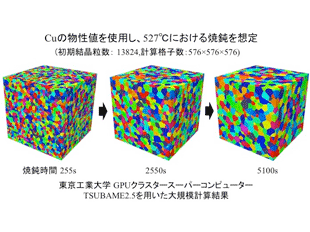先端材料・デバイス開発を加速するフェーズフィールド法を基軸としたシミュレーション技術の開発
メンバー: 山中晃徳
分野: 計算科学、機械工学、材料工学、総合工学
所属: 工学研究院
キーワード: フェーズフィールド法、 有限要素法、 材料開発、 高強度鋼、 Phase-Field Method、 Finite Element Method、 Materials Development、 High Strength Steel
ウェブサイト:
研究概要

我々の研究グループでは、金属材料の加工・熱処理中に生じる凝固、相変態、再結晶などによるミクロ組織形成を数値シミュレーションにより解析、予測するための強力な手法として発展しているフェーズフィールド法の研究を行っています。フェーズフィールド法は、金属材料組織形成以外にも、セラミックスやポリマーなどの他、最近ではリチウムイオン電池や燃料電池内で生じる電気化学的反応のシミュレーション方法としても発展してきています。本研究グループでは、有限要素法など構造解析手法と組み合わせた数値解析法も開発しており、機械、材料、電気、化学にまたがる幅広い分野への応用を目指しています。さらには、GPUなどの高速計算技術の研究やスーパーコンピューターでの大規模計算も行っており、実用材料や実デバイス開発においては必要不可欠な3次元シミュレーションの高速化も推進している。
主要論文・参考事項
・岡本成史, 山中晃徳, 下川辺隆史, 青木尊之, マルチフェーズフィールド法による多結晶粒成長シミュレーションの複数GPU計算, 日本計算工学会論文集, Vol.2013, (2013), p.20130018.
・Akinori Yamanaka, Tomohiro Takaki, Takayuki Aoki and Takashi Shimokawabe, Multiphase Field Simulation of Austenite-to-Ferrite Transformation Accelerated by GPU Computing, Journal of Computational Science and Technology, 6, (2012), pp.182-197.
・Akinori Yamanaka, Tomohiro Takaki and Yoshihiro Tomita, Simulation of Austenite-to-Ferrite Transformation in Deformed Austenite by Cyrstal Plasticity Finite Element Method and Multi-Phase-Field Method, ISIJ International, Vol.52, No.4, (2012/4), pp.659-668.
・高木知弘, 山中晃徳 共著, フェーズフィールド法 -数値シミュレーションによる材料組織設計-, 養賢堂, (2012).
・A. Yamanaka, T. Takaki and Y. Tomita, Coupled Simulation of Microstructural Formation and Deformation Behavior of
Ferrite-Pearlite Steel by Phase-Field Method and Homogenization Method, Materials Science and Engineering A, (2008/5), Vol.480, pp.244-252.
動画
フェーズフィールドシミュレーションで解析可能な多結晶粒成長挙動
お問い合わせ先
東京農工大学・先端産学連携研究推進センター
urac[at]ml.tuat.ac.jp([at]を@に変換してください)
Development of Advanced Materials Design Simulation Tool based on Phase-Field Method
Research members: Dr. Yamanaka Akinori
Research fields: Computational science, Mechanical engineering, Material engineering, Integrated engineering
Departments: Institute of Engineering
Keywords: Phase-Field Method, Finite Element Method, Materials Development, High Strength Steel
Web site:
Summary

We have developed a novel numerical technique to simulate microstructure evolutions in metallic materials during solidification, phase transformation and recrystallization by using phase-field method. The phase-field method has attracted much attention as a powerful simulation tool for simulating the microstructure evolutions. Recently, the method has been applied to simulate electrochemical phenomenon in lithium ion battery and fuel battery. Furthermore, we develop a new simulation method coupled the phase-field method with finite element method to apply it to various field, such as mechanical engineering, materials science, electric engineering and chemical engineering. We have also develop parallel computing technique using GPU to accelerate three-dimensional simulation which is necessary to develop practical materials and devices.
Reference articles and patents
・岡本成史, 山中晃徳, 下川辺隆史, 青木尊之, マルチフェーズフィールド法による多結晶粒成長シミュレーションの複数GPU計算, 日本計算工学会論文集, Vol.2013, (2013), p.20130018.
・Akinori Yamanaka, Tomohiro Takaki, Takayuki Aoki and Takashi Shimokawabe, Multiphase Field Simulation of Austenite-to-Ferrite Transformation Accelerated by GPU Computing, Journal of Computational Science and Technology, 6, (2012), pp.182-197.
・Akinori Yamanaka, Tomohiro Takaki and Yoshihiro Tomita, Simulation of Austenite-to-Ferrite Transformation in Deformed Austenite by Cyrstal Plasticity Finite Element Method and Multi-Phase-Field Method, ISIJ International, Vol.52, No.4, (2012/4), pp.659-668.
・高木知弘, 山中晃徳 共著, フェーズフィールド法 -数値シミュレーションによる材料組織設計-, 養賢堂, (2012).
・A. Yamanaka, T. Takaki and Y. Tomita, Coupled Simulation of Microstructural Formation and Deformation Behavior of
Ferrite-Pearlite Steel by Phase-Field Method and Homogenization Method, Materials Science and Engineering A, (2008/5), Vol.480, pp.244-252.
Movie
Polycrystalline grain growth simulated by phase-field method.
Contact
University Research Administration Center(URAC),
Tokyo University of Agriculture andTechnology
urac[at]ml.tuat.ac.jp
(Please replace [at] with @.)

